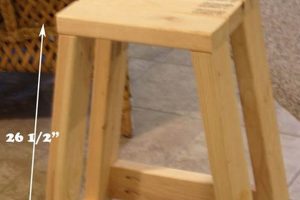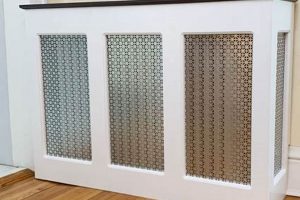A do-it-yourself project involving the creation of a wearable garment designed to hold added weight. This garment, commonly constructed from durable materials and incorporating pockets or compartments, allows individuals to customize the resistance encountered during various activities. A practical example involves modifying a standard vest by sewing in pouches to accommodate sandbags or metal weights, thereby increasing the load borne by the wearer.
The significance of constructing such a garment lies in its potential to enhance physical performance and rehabilitation efforts. Adding resistance through a weighted garment can promote strength gains, improve cardiovascular fitness, and contribute to increased bone density. Historically, weighted clothing has been utilized in training regimens across various disciplines, from athletics to military preparedness, offering a cost-effective and adaptable method for progressive overload training.
The subsequent sections will detail construction techniques, material considerations, weight selection guidelines, and safety precautions pertinent to successfully and safely creating a customized weighted garment. This guide aims to provide the necessary information for individuals to undertake this project with confidence and achieve the intended benefits.
Essential Considerations for Constructing a Weighted Garment
The following recommendations are crucial for ensuring the effectiveness and safety of a homemade weighted garment. Careful attention to these details will contribute to a positive and productive experience.
Tip 1: Material Selection: Opt for heavy-duty fabrics such as canvas, Cordura nylon, or reinforced denim. These materials exhibit superior durability and resistance to tearing, essential for withstanding the stress of added weight. Reinforce seams with multiple rows of stitching using a heavy-duty thread.
Tip 2: Weight Distribution: Strategically position weight pockets to achieve balanced loading. Avoid concentrating weight in a single area, as this can lead to discomfort and potential injury. Even distribution promotes proper posture and reduces strain on specific muscle groups.
Tip 3: Secure Weight Compartments: Implement robust closures for weight pockets, such as zippers, Velcro straps, or button snaps. This prevents weights from shifting or falling out during activity, ensuring consistent resistance and minimizing the risk of accidents. Regularly inspect closures for wear and tear.
Tip 4: Progressive Weight Increments: Begin with a modest weight load and gradually increase resistance over time. This allows the body to adapt and reduces the likelihood of overexertion or injury. A starting point of 5-10% of body weight is generally recommended.
Tip 5: Proper Fit and Adjustability: The garment should fit snugly but not restrict movement. Incorporate adjustable straps or closures to accommodate variations in body size and clothing layers. A secure fit prevents the garment from shifting during exercise.
Tip 6: Cleaning and Maintenance: Establish a routine for cleaning and maintaining the garment. Remove weights and hand-wash or machine-wash the vest according to the fabric’s care instructions. Proper hygiene prevents the buildup of sweat and bacteria.
The implementation of these guidelines will facilitate the creation of a safe and effective weighted garment, maximizing its potential benefits while minimizing associated risks. Adherence to these principles contributes to a sustainable and productive training regimen.
The subsequent sections will explore advanced construction techniques and specialized applications of weighted garments, catering to individuals with specific training goals or rehabilitation needs.
1. Material Durability
Material durability is a paramount consideration in the context of constructing a do-it-yourself weighted vest. The inherent nature of the garment, designed to bear significant and repetitive stress, necessitates the selection of robust and resilient materials. Failure to prioritize material integrity can lead to premature degradation of the vest, compromised safety, and ultimately, a diminished training experience.
- Tensile Strength
Tensile strength, defined as the material’s resistance to breaking under tension, is crucial. For a weighted vest, this translates to the fabric’s ability to withstand the constant pull of the added weight. High tensile strength materials like Cordura nylon or heavy-duty canvas are preferred. If a weaker material is used, like a regular cotton blend, the pockets may tear under the weight, releasing the weights and potentially causing injury. This characteristic is the first line of defense of vest from breaking.
- Abrasion Resistance
Abrasion resistance refers to the material’s ability to withstand surface wear caused by rubbing or friction. A weighted vest is likely to experience abrasion from contact with the wearer’s body, clothing, and external surfaces during training activities. Materials with high abrasion resistance, such as ballistic nylon or reinforced denim, will maintain their integrity for a longer period. A vest made with low abrasion resistance materials might show wear after only a few workout cycles and can break.
- Seam Strength
While the primary material contributes significantly to overall durability, the strength of the seams is equally vital. Weak seams can become points of failure, even if the main fabric is exceptionally strong. Using heavy-duty thread and employing reinforced stitching techniques, such as double or triple stitching, is essential to ensure that the seams can withstand the stress imposed by the weight. Without attention to the seam strength, the benefits of a good vest material are almost useless.
- Resistance to Environmental Factors
The longevity of a homemade weighted vest is also influenced by its resistance to environmental factors. Exposure to moisture, sunlight, and temperature fluctuations can degrade certain materials over time. Opting for materials with inherent resistance to these elements or applying protective coatings can extend the vest’s lifespan. For example, certain fabrics are prone to rotting if in a wet environment, which causes vest degrading.
In conclusion, material durability is not merely a superficial aspect of crafting a DIY weighted vest; it is a foundational element that directly impacts its safety, functionality, and long-term value. By carefully considering tensile strength, abrasion resistance, seam integrity, and resistance to environmental factors, one can create a garment that effectively supports training goals while providing years of reliable service. The durability directly impacts the cost savings that come with constructing a do-it-yourself vest, as a more expensive, durable material might save money in the long run.
2. Weight Distribution
Weight distribution represents a critical design consideration in the construction of a do-it-yourself weighted vest. The placement and uniformity of added weight directly influence the garment’s comfort, functionality, and potential for injury. An uneven distribution of weight can lead to musculoskeletal imbalances, discomfort, and compromised exercise form, thereby negating the intended benefits of resistance training. For instance, concentrating weight solely on the front of the vest can cause excessive strain on the lower back, predisposing the wearer to pain and potential injury. Conversely, an even distribution of weight across the torso promotes proper posture, engages core musculature, and facilitates a more balanced and effective workout. This careful configuration is a significant factor for ensuring the proper performance and outcome of the weight vest.
The practical application of proper weight distribution extends to various activities. During running, an unbalanced vest can disrupt gait mechanics, leading to inefficient movement and increased risk of joint stress. By contrast, a balanced vest allows for a natural stride, promoting cardiovascular fitness and strength gains without compromising form. Similarly, during strength training exercises such as squats or push-ups, even weight distribution ensures symmetrical muscle activation, optimizing strength development and preventing compensatory movement patterns. Many workout routines are already complex enough, making it dangerous to have a shifting or unbalanced weight during those routines. Examples of successful designs often include multiple small weight pockets strategically placed to cover the upper torso, both front and back, and securing the pockets with multiple securing methods.
In summary, weight distribution is not merely an aesthetic detail but rather a fundamental engineering principle in the design and utilization of a homemade weighted vest. Prioritizing even weight distribution is essential for maximizing training benefits, minimizing the risk of injury, and ensuring overall comfort and functionality. Overcoming challenges associated with achieving optimal weight distribution requires careful planning, precise construction, and a thorough understanding of biomechanics. Failure to address this critical element can render the vest ineffective or even counterproductive, highlighting the paramount importance of thoughtful weight distribution in the realm of “diy weighted vest” construction. Weight distribution is arguably the single most important element in DIY weight vest construction, because a small error in design and material choices can lead to injury for the user. This highlights the importance of researching or sourcing a professional to assist in design.
3. Secure Fastenings
Secure fastenings represent a non-negotiable aspect of any do-it-yourself weighted vest. Their functionality directly impacts the safety and efficacy of the garment. The primary cause for concern stemming from inadequate fastenings is the potential for weights to dislodge during use. This occurrence can lead to immediate physical hazards, such as trips and falls, particularly during dynamic activities. The effect of such an event extends beyond physical injury to include compromised training intensity and disrupted exercise form. A vest with unreliable closures undermines the entire purpose of added resistance, creating more risk than reward. Examples of inadequate fastenings include poorly stitched Velcro straps that detach under load, zippers that spontaneously open due to insufficient strength, or simple button closures incapable of withstanding repetitive stress. In each case, the failure of the fastening mechanism negates the benefits of the vest and introduces significant safety concerns. The practical significance of understanding this lies in recognizing the need for robust and redundant fastening systems.
Further analysis reveals that selecting appropriate fastening methods demands careful consideration of weight load, activity type, and material compatibility. High-intensity activities necessitate more secure closures, such as heavy-duty zippers combined with additional straps or buckles. The choice of material for the fastening system must align with the vest’s primary fabric to ensure durability and prevent premature wear. For instance, using flimsy plastic buckles on a vest constructed from heavy-duty canvas creates a point of vulnerability. Military-grade buckles, reinforced stitching, and multi-layered securing mechanisms are features incorporated into commercial designs to mitigate the risk of failure. Replicating these features, to the greatest extent feasible, is crucial for any individual embarking on a DIY weighted vest project. A secure system also enables the user to dynamically adjust the weight in the vest.
In conclusion, secure fastenings are not merely an accessory but an integral structural component of a safe and effective DIY weighted vest. The failure of these systems results in potential physical harm and undermines the entire training objective. Addressing this challenge demands meticulous planning, careful material selection, and robust construction techniques. The ultimate goal is to create a garment that provides reliable and consistent resistance, allowing individuals to pursue their fitness goals without compromising safety. Secure fastenings allow the weights to remain in place throughout the exercise, and allow the user to adjust the weight to dynamically adjust the exercise to maximize output.
4. Progressive Overload
Progressive overload constitutes a foundational principle in resistance training, dictating the gradual increase in stress placed upon the musculoskeletal system to elicit adaptation and subsequent improvement in strength, endurance, and muscle hypertrophy. The “diy weighted vest” serves as a readily adaptable tool for implementing this principle. The vest’s inherent design facilitates the incremental addition of weight, allowing individuals to systematically increase the resistance encountered during various exercises. For instance, an individual performing bodyweight squats can initially utilize the vest with a minimal weight load, subsequently increasing the weight in small increments as their strength and endurance improve. This controlled progression mitigates the risk of injury associated with abrupt increases in training intensity. The absence of progressive overload renders training ineffective; the body adapts to a constant stimulus, negating further gains. The “diy weighted vest,” when strategically employed, provides a direct means to manipulate this critical variable. The user should start small weight and increase overtime.
Furthermore, the practical application of progressive overload with a “diy weighted vest” extends beyond basic bodyweight exercises. The vest can be integrated into a diverse range of activities, including walking, running, plyometrics, and calisthenics, providing a versatile method for enhancing training stimulus across various fitness domains. For example, a runner can initially utilize the vest during short, low-intensity runs, gradually increasing the weight load and distance as their cardiovascular fitness improves. The adaptability of the “diy weighted vest” allows for precise manipulation of training variables, facilitating targeted improvements in specific areas of fitness. This controlled manipulation becomes difficult when there is no proper weighted vest
, because the user is not adding weight in the right positions. In addition, this adaptation must also come with a healthy diet to facilitate muscle growth.
In conclusion, the “diy weighted vest” represents a practical and adaptable instrument for implementing the principle of progressive overload in resistance training. Its capacity for incremental weight adjustments allows individuals to systematically challenge their musculoskeletal system, leading to sustained improvements in strength, endurance, and overall fitness. However, responsible application is paramount. Progress must be deliberate and measured to minimize the risk of injury. The efficacy of the “diy weighted vest” is contingent upon a clear understanding of progressive overload principles and a commitment to safe and responsible training practices. Without a progressive overloading, the individual is not maximizing their gains and using the weight incorrectly.
5. Adjustable Fit
The concept of adjustable fit is of critical importance in the context of a do-it-yourself weighted vest. A properly fitted vest ensures comfort, optimizes performance, and minimizes the risk of injury. The absence of adjustability can render the vest ineffective or even dangerous, as a loose or ill-fitting garment can shift during activity, leading to unbalanced weight distribution and potential strain.
- Torso Length Accommodation
Variations in torso length necessitate adjustability. A vest that is too long or too short will not distribute weight effectively and may restrict movement. Adjustable shoulder straps or torso straps allow the user to customize the vest’s length to match their individual anatomy. Failure to accommodate torso length can result in the weight resting improperly on the shoulders or hips, causing discomfort and potential injury. Commercial vests often provide a range of torso length settings, and DIY designs should attempt to replicate this functionality through adjustable straps or modular designs.
- Circumference Adjustment
The vest’s circumference must be adjustable to accommodate varying body sizes and clothing layers. Side straps or buckles allow the user to tighten or loosen the vest to achieve a snug but not constricting fit. A vest that is too tight can restrict breathing and circulation, while a vest that is too loose can shift excessively during movement. DIY designs often incorporate Velcro straps or elastic panels to provide a degree of circumference adjustability. Without proper adjustment, any exercise can be dangerous if there is too much restrictive movement or improper weight placements.
- Weight Pocket Customization
Adjustable weight pockets contribute to overall fit by allowing the user to fine-tune the weight distribution. The ability to reposition or remove weight pockets enables a more balanced and comfortable load. For example, individuals with larger chests may prefer to concentrate more weight on the back of the vest to compensate for the difference in mass. Adjustable weight pockets can be achieved through modular pocket designs or straps that allow the user to reposition the weights. Customization in placement maximizes performance and optimizes training.
- Secure Closure Mechanisms
Adjustable fit is closely linked to the security of the vest’s closure mechanisms. Straps, buckles, and zippers must be durable and adjustable to maintain a secure fit during vigorous activity. Loose or unreliable closures can lead to the vest shifting or even falling off, posing a significant safety hazard. DIY designs should prioritize high-quality closures and reinforced stitching to ensure a secure and adjustable fit. Without that, a shifting vest can unbalance the user in performing the exercise.
In conclusion, adjustable fit is not merely a matter of comfort but a critical design element that directly impacts the safety, effectiveness, and overall utility of a DIY weighted vest. Accommodating torso length, adjusting circumference, customizing weight pocket placement, and ensuring secure closures are all essential considerations in the construction of a well-fitting and functional garment. The user needs to accommodate their specific needs and requirements.
6. Hygiene Maintenance
Hygiene maintenance, in the context of a do-it-yourself weighted vest, extends beyond mere cleanliness; it represents a crucial factor influencing the longevity of the garment, the health of the user, and the overall effectiveness of the training regimen. Neglecting hygiene considerations can lead to the proliferation of bacteria, unpleasant odors, and accelerated material degradation, ultimately compromising the vest’s utility and posing potential health risks.
- Sweat Absorption and Bacterial Growth
The primary concern regarding hygiene revolves around the absorption of sweat. Weighted vests, designed for physical exertion, inevitably become saturated with perspiration. Sweat provides a breeding ground for bacteria, leading to unpleasant odors and potentially causing skin irritations or infections. Fabrics that retain moisture exacerbate this issue. Regular cleaning and the use of moisture-wicking materials can mitigate bacterial growth and maintain a hygienic environment. For example, an untreated vest can develop mildew and a persistent odor after only a few uses, requiring extensive cleaning or replacement. It is essential to minimize bacterial growth for safety and cleanliness.
- Material Degradation and Odor Retention
Prolonged exposure to sweat and bacteria can accelerate the degradation of the vest’s materials. Fabrics may weaken, seams may fray, and padding may compress, reducing the garment’s structural integrity and overall lifespan. Odor retention is another significant consequence, rendering the vest unpleasant to wear and potentially discouraging consistent use. Utilizing durable, washable materials and implementing a consistent cleaning schedule can prevent premature degradation and minimize odor retention. An example of this would be the rotting of the fabric and tearing that occurs when not using high-quality fabrics.
- Cleaning Protocols and Frequency
Establishing and adhering to a consistent cleaning protocol is essential for maintaining hygiene. The frequency of cleaning depends on the intensity and frequency of use. Vests used daily for high-intensity workouts require more frequent cleaning than those used sporadically for low-impact activities. Hand-washing with mild detergent or machine-washing on a gentle cycle are common cleaning methods. Ensuring thorough drying after cleaning is critical to prevent mildew growth. Users should use a gentle detergent and avoid harsh chemicals.
- Weight Management and Hygiene Integration
The weights themselves, particularly if made of porous materials like sand, can also harbor bacteria and moisture. Removable weights facilitate easier cleaning and drying of both the vest and the weights. Regularly inspecting and cleaning the weight pockets or compartments is essential. Using sealed or non-porous weights can further minimize the risk of bacterial contamination. A simple swap of material can avoid mildew growth in the vest.
In conclusion, hygiene maintenance is not a peripheral concern but an integral aspect of owning and utilizing a DIY weighted vest. By addressing sweat abs
orption, material degradation, cleaning protocols, and weight management, individuals can maximize the lifespan of their garment, safeguard their health, and ensure a consistently positive training experience. Failure to prioritize hygiene can lead to a cascade of negative consequences, highlighting the importance of proactive and consistent maintenance practices.
7. Activity Specificity
Activity specificity, in the context of a do-it-yourself weighted vest, refers to the tailoring of the vest’s design, construction, and weight distribution to the demands of a particular physical activity. A vest optimized for one activity may be suboptimal or even detrimental for another. Therefore, a comprehensive understanding of the intended application is paramount during the design and construction phase.
- Weight Distribution and Exercise Biomechanics
Weight distribution must align with the biomechanical requirements of the targeted exercise. For running, even weight distribution across the torso minimizes gait disruption and prevents asymmetrical loading. In contrast, for strength training exercises like pull-ups, a concentration of weight around the upper back may enhance muscle activation. A vest designed for general use may compromise performance in specialized activities. The user also requires to adjust the vest for the activity.
- Range of Motion and Vest Profile
The vest’s profileits bulk and shapemust not impede the range of motion required for the activity. A bulky vest may restrict arm movement during swimming or upper-body exercises. A streamlined vest with a minimal profile is better suited for activities requiring a full range of motion. Activity dictates design and can hinder progress if not incorporated.
- Impact Considerations and Material Selection
Activities involving impact, such as plyometrics or martial arts training, necessitate a vest constructed from impact-resistant materials. Padding and reinforcement in key areas can mitigate the risk of injury. A vest designed primarily for walking may lack the necessary protection for high-impact activities. The design choices must match the rigors of the activity.
- Environmental Factors and Vest Materials
Environmental factors influence material selection. A vest designed for outdoor use in hot climates should utilize breathable, moisture-wicking fabrics. A vest intended for water activities requires water-resistant or quick-drying materials. The properties must align with the environmental conditions. The material also contributes to the durability of the vest for multiple uses in the activity.
The four facets above highlight the essential relationship between activity specificity and DIY weighted vest construction. The more that the user considers the activity, the better results they can generate from the vest. When incorporating the activity, performance is enhanced, there is a reduction in risk of injury, and optimization of the vest’s design and construction is implemented.
Frequently Asked Questions
The following section addresses common inquiries and concerns related to the construction and use of a homemade weighted vest. The information presented aims to provide clarity and guidance for individuals considering this project.
Question 1: What materials are most suitable for constructing a durable and safe DIY weighted vest?
Heavy-duty fabrics such as canvas, Cordura nylon, or reinforced denim are recommended due to their high tensile strength and abrasion resistance. Seams should be reinforced with heavy-duty thread and multiple rows of stitching. Fastenings should consist of robust zippers, buckles, or Velcro straps capable of withstanding significant stress.
Question 2: How should weight be distributed within a DIY weighted vest to ensure optimal comfort and prevent injury?
Weight should be distributed evenly across the torso to maintain balance and prevent strain on specific muscle groups. Multiple small weight pockets strategically positioned on the front and back of the vest are preferable to concentrating weight in a single area.
Question 3: What type of weight is appropriate for a DIY weighted vest, and how should it be secured within the vest?
Sandbags, metal shot, or specialized weight plates are suitable options. The weight should be securely contained within individual pockets or compartments with reliable closures to prevent shifting or dislodging during activity.
Question 4: How much weight should be added to a DIY weighted vest, and how should the weight be increased over time?
Individuals should begin with a weight load of approximately 5-10% of their body weight and gradually increase the weight in small increments as their strength and endurance improve. It is crucial to listen to the body and avoid overexertion.
Question 5: How should a DIY weighted vest be cleaned and maintained to prevent the growth of bacteria and prolong its lifespan?
The vest should be hand-washed or machine-washed on a gentle cycle with mild detergent. Thorough drying is essential to prevent mildew growth. Weight pockets and compartments should be regularly inspected and cleaned to remove any accumulated sweat or debris.
Question 6: Are there any specific exercises or activities that are not recommended when using a DIY weighted vest?
Activities that place excessive strain on the joints or spine, such as high-impact jumping or twisting movements, should be approached with caution. Individuals with pre-existing musculoskeletal conditions should consult with a healthcare professional before using a weighted vest.
In summary, the construction and utilization of a DIY weighted vest require careful consideration of materials, weight distribution, weight selection, progressive overload, hygiene maintenance, and exercise selection. Adherence to these guidelines promotes safety and maximizes the potential benefits of this training tool.
The subsequent section will explore advanced modifications and customization options for individuals seeking to further optimize their DIY weighted vest.
Conclusion
This exploration of “diy weighted vest” construction underscores the multifaceted nature of this undertaking. Key considerations, ranging from material selection and weight distribution to safety protocols and activity-specific design, collectively determine the efficacy and longevity of the finished product. A successful project requires meticulous planning, precise execution, and a thorough understanding of biomechanical principles.
The potential benefits of a well-constructed “diy weighted vest,” including enhanced strength, improved cardiovascular fitness, and increased training versatility, warrant the diligent effort required. However, responsible implementation is paramount. Individuals embarking on this project must prioritize safety, adhere to established guidelines, and exercise caution to avoid injury. Continued research and refinement of construction techniques will further enhance the value and safety of “diy weighted vest” projects in the future.







